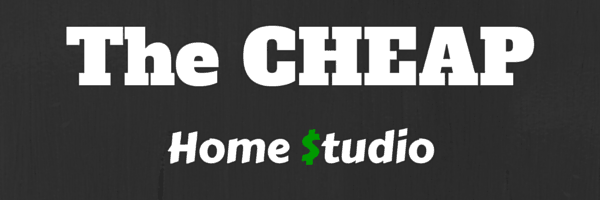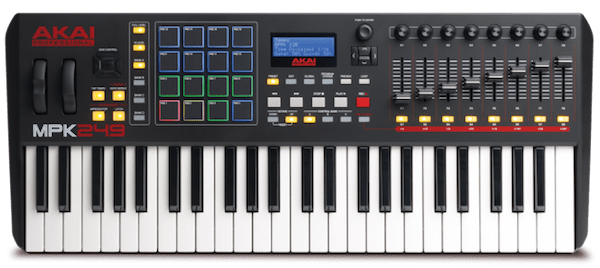The Cheap Home Recording Studio: Is It Possible?
When most people think of a “recording studio”, what automatically comes into their minds would be a large, expensive setup of mixers, instruments, high-end synths, and not forgot an impressive set of large studio monitors.
Unfortunately, a large amount of beginners fall into the trap of thinking you have to spend 10s-of-thousands of dollars just to set up your own home recording studio.
This is not generally true.
A lot of musicians nowadays enjoy being “bedroom producers” and make their music without buying ultra-expensive gear.
Keep in mind that you don’t have to buy everything at once. Start out by buying a few essential studio components, and grow your gadget-collection as you go.

What Software Should You Use?
A DAW (Digital Audio Workstation) is the software you use to compose, mix, and master your own tunes.
There is a saying that “a DAW is only as good as its producer”. What this means is that just because you own a $600 workstation, it doesn’t mean that you’ll be making bangers right out of the box.

Fruity Loops Studio (FL Studio):
FL Studio is perhaps the most well-renowned and commonly-used DAW in the world due to its user-friendly interface and its vast collection of video tutorials.
If you are starting out in music, this DAW will do everything you need and more. FL Studio is most commonly used by hip-hop and house music producers.

Ableton Live:
Ableton Live is my favorite DAW. It is a well-designed DAW that comes with top-notch plugins and instruments right out of the box.
Many producers choose Ableton for its workflow. After a few hours of messing around, you’ll discover how fast it is to navigate through menus and put down ideas.
A unique feature of Ableton is its ability to be used for live performance. You can launch clips, loop instruments, and even DJ with Ableton Live.
Overall, Ableton is a very worth-while DAW that you should at least consider.

Logic Pro:
If you are an Apple Fanatic and love every piece of software they put out, Logic Pro is worth looking into.
A huge library of surprisingly great-sounding samples and instruments are included. Logic Pro was designed with the Apple-user in mind.

LMMS:
Ok… So maybe you don’t want to throw down over $100 to buy a DAW. Maybe you don’t even know if music production is for you.
No worries! LMMS is a beautifully designed DAW that will get you producing music for free. You’ll find some good tutorials on LMMS, but the user-base is nothing compared to more popular options such as Ableton or FL Studio.
Do You Need A Midi Controller?
A MIDI Keyboard is something to make your production and note sequencing a lot easier and more natural, especially if you prefer inputting notes as you play rather than sequencing by the mouse.
Its a good idea to have a midi keyboard in your studio even if you aren’t an expert pianist. Having physical keys in front of you makes it easy, after a bit of practice, to come up with melodies out of thin air.
You may start with a 25-key if you intend to use it for simple synth leads without a whole lot of melodic range, but if you want to play your midi keyboard like a normal piano, try going with a keyboard in the range of 49-81 keys. (If you can afford an 81-key keyboard, go for it! The only downside of a larger keyboard is that it requires more room)

AKAI is known for putting out professional gear. The Akai MPK429 is a great start for any home studio. Unlike most keyboards you see in the market, this one has tons of features including a wide range of knobs and pads
The MPK249 is also great for creating live music and loops. It includes Ableton Live Lite as well!
When Do You Need an Audio Interface?
Commercial PCs already have sound cards – but what’s with the need for another audio interface?
Speaking production-wise, most professionals recommend the use of an external digital audio interface to connect your gadgets.
The biggest reason to buy an audio interface is for connecting your instruments and microphones. 99% of audio interfaces put out today have phantom power built in meaning that you can connect a condenser microphone.

For starters, try the Focusrite Scarlett 18i8.
It’s been hailed for years as a top dog when it comes to professional-sounding entry-level audio interfaces, You can connect and record all of your instruments at the best quality possible.
If you are on an even slimmer budget, the Scarlett 2i2 will suffice.
Should You Get A USB Microphone, or an XLR Microphone?

If you’re a beginner producer, chances are you’ll have a simple USB microphone, which is generally cheaper and easier to find.
The biggest reason usb mics aren’t used in professional studios is their lack of high-quality and their limited expandability.
The best way to go for any home recording studio is an XLR microphone. There are a whole bunch of reasons why an XLR microphone is a much smarter choice. You can check out my USB VS. XLR article for more information.
Should You Use Headphones Or Studio Monitors?

The “studio headphones vs. studio monitors debate” has been a long-time discussion in the production industry. Both of these listening devices have their own pros and cons.
Headphones are much more affordable, but produce a sound that is less flat and artificially wide.
Studio Monitors produce a much more accurate sound, but cost more. If you have roommates or neighbors, there’s a good chance they won’t appreciate late-night studio sessions.
Refer to my best studio monitors resource for some great options.
Important Side Note: Don’t make the mistake of buying a pair of studio monitors that cost less than $200. Just because they are labeled “studio monitors” doesn’t mean that they’ll give you studio quality. You get what you pay for!
The final verdict: Both are great choices and have seperate purposes. If you are on a tight budget, the Audio Technica ATH-M50x will do just fine.
For a more visual comparison, you can check out my Studio Monitors VS Headphones Infographic.
Acoustic Treatment
If you’ve been to a recording studio or band rehearsing studio, you’ll probably find soundproofing walls all over the room.
This is because they use acoustic treatment. Acoustic treatment is essentially a technique that’s used to help your sound be absorbed by walls instead of being bounced back and lead to a muddy mix inside your room.
If you aren’t planning on doing a whole lot of recording when you start, you can ignore acoustic treatment for now.
The cheapest way to give acoustic treatment to your home studio is a DIY soundproofing project.
Final Notes
See? Setting up a home recording studio doesn’t have to be a daunting, expensive task.
A lot of big-name producers literally spend thousands to millions to set up their personal home studios.
As a beginner, you don’t need big pockets to get started.
Don’t buy all of your equipment at once. Buy as-you-go and take time to learn your gear. This will give you a much smoother and less-stressful learning experience.

Leave a Comment